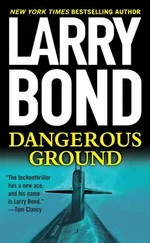He showed Shimko the small map. “I’m still working the numbers to make sure we can still reach the remaining UUV launch and recovery points as planned. Until we actually start the second set of surveys, all I can do is estimate how long each one will take.”
Shimko agreed, reluctantly. “Just give me your best guesstimate. I’ll brief the Skipper, but I need your recommendations ASAP”
Jerry glanced at the chart table behind him. “Twenty minutes, sir?”
“All right. Did Patty find anything unusual?”
Jerry gestured to the chart table behind him. “A gold mine of hydro-graphic data. I’ve got my guys working through it for obstructions, shoals, anything not on the charts.” He paused. “She also marked over thirty man-made objects. I’ve compared their locations with ones we knew about on the charts. Only a handful match. Most are new or uncharted.”
“Good. The same vessel that plants the sensors can examine those items.”
“Should we use the UUVs to classify some of the bigger ones? We can tell the vehicle to take photos and sonar images when it detects one.”
“No. A lot of that stuff is going to be old — leftovers from World War II or maybe just junk dumped out here. Besides, we have over two hundred new bottom contacts right now. We’d lose way too much time finding out which ones were worth exploiting.” Shimko smiled. “Wise man says, ‘Man who looks for noodle in haystack will be very hungry.’”
Jerry looked disappointed. Shimko reminded him, “We’ve got our own mission to finish, and I’d prefer not to poke around up here any more than we absolutely have to.”
“Yessir, I understand. I’ll have my course recommendations to you in a few minutes.”
* * *
Seawolf glided confidently over the seabed at a stately five knots. As they doubled back to the rendezvous location to pick up LaVerne, the bottom crested within five fathoms of her keel, but they were following in Patty’s path now. Jerry was confident of the data from the UUV, and his quartermasters were already adding Patty’s bottom topography data to their charts. They would leave the Barents with better charts than the Russians, at least where the UUVs had been.
The first of eight detail surveys had gone as planned. Lieutenant (j.g.) McClelland, the sonar officer, and Jerry had worked out a procedure to gather additional hydroacoustic information that they needed, while Jerry plotted their precise position. He now had almost every quartermaster aboard working in control. Either they were updating charts or plotting the detailed survey data. Jerry had to fight the urge to use the quartermaster assigned to the control room watch. Their activities took over the fire-control plotting table as well as the chart table in control. And the extra bodies made the space both crowded and stuffy.
Jerry noted and reported the proximity of several newly plotted man-made objects along their course. Patty’s navigational accuracy was precise enough to reassure the entire ship control team that they were well clear of any of them. According to his plot, the nearest object approached no closer than two thousand yards on Seawolf’s port side.
* * *
The Russian sensor buoy listened carefully as the sound from Seawolf grew louder. Its sound receivers covered a wide range of frequencies, and now it isolated tones, pulses, rhythmic sounds that were not only man-made, but fit its detection criteria. It still waited, though. It detected and classified the sounds from the intruder within minutes, but would they persist? Would they change?
They didn’t change, but grew steadily louder at a constant rate. The sounds made by Seawolf were no louder than a household appliance, but the buoy had more than enough to work with.
The buoy’s computer was smart enough to recognize this as an approaching vessel, so waited, gathering and recording sounds. Finally, the intensity began to fade, at the same rate it had increased, and the bearing rate changed dramatically. The buoy realized that the submarine was moving away. It had gotten all the information that it was going to get, and it was time to report to its masters.
It uploaded its recordings and all target data, along with a message, into a small float, one of three located at the top of the buoy. The computer verified that the surface was clear of large ice chunks, and then released a catch. The float silently shot up toward the surface.
Seawolf was several miles away when the Russian sensor buoy broke the surface and broadcasted her presence.
4 October 2008
Severodvinsk
Barents Sea, five nm south of the Amga Buoy Line
Petrov was in the aft auxiliary machinery compartment when the summons came over the intercom: “CAPTAIN TO CENTRAL POST.” There was an urgency in the speaker’s tone, and Petrov wondered what new disaster had befallen them. There was no sign of anything amiss in the engineering plant. Chief Engineer Lyachin had just been showing him the improvised repairs to one of the motor generators, and Petrov had praised his resourcefulness.
Heading forward from the sixth compartment, Petrov used the process of elimination to try and bound the problem. The reactor and propulsion plant were both functioning within safe limits. If not engineering, then weapons? Unlikely, since they weren’t exercising those systems. Sailors saw him coming and flattened themselves against the passageway bulkheads, or ducked into doorways. The captain was in a hurry.
Sensors? Possible, he thought. Communications? Also a possibility. Each new suggestion made him increase his pace. As he leapt through the watertight doors, Petrov clutched the red case containing his IDA-59M close to his chest. The self-contained breathing apparatus was issued to everyone on board a Russian submarine and was designed to provide fifteen minutes of breathable air. That was long enough for a person to evacuate a compartment filled with thick, choking smoke.
In the central post, Kalinin started his report as soon as Petrov came into “It’s an alert, sir-an Urgent message from Northern Fleet Headquarters. I’ve ordered the boat to communications depth. Sonar reports no contacts.”
Petrov’s anxiety quickly changed to curiosity, mixed with impatience. He thought, “I hope it’s something other than a drill this time.”
There were several levels of importance or precedence used in fleet messages. “Routine” messages were the administrative trash that he and the rest of his officers plowed through every day. “Priority” messages concerned fleet operations, and were handled quickly, if the communications commander wanted to keep his job. “Urgent” messages had to be passed instantly. If America attacked, the fleet would be warned by an Urgent alert message.
The cautious Kalinin, like any good starpom, would not usually have maneuvered the boat without permission from his captain, but this was an exception. With an alert message, there could be no delay. Minutes might count. Petrov nodded his approval of Kalinin’s actions and asked, “Is Mitrov ready?”
“Yes, comrade Captain. He’s in the communications post and will keep us appraised.”
Petrov watched the depth gauge rise. They’d been loitering near the edge of the sea ice, a hundred meters down. At that depth, Severodvinsk had to trail a long wire antenna to receive any signals at all, and they were limited to simple one-word codes — like “Alert!” That was the tradeoff with extremely-low-frequency communications. A submarine could receive messages at deeper depths, but they were incredibly short owing to the low bandwidth — little more than a “bell ringer” telling a boat to make contact. They’d received just such a message, calling them toward the surface where they could receive a more detailed message using a faster system.
Читать дальше












